Category Archives: Improve Your Life
Kieran’s Our City, Our Town, 5 September 2024
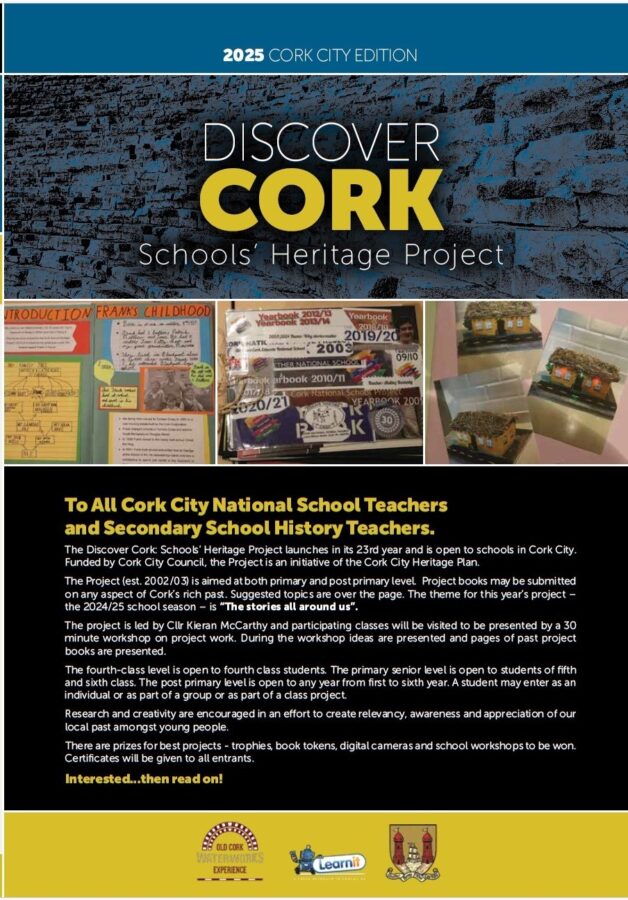
Kieran’s Our City, Our Town Article,
Cork Independent, 5 September 2024
Launch of Discover Cork: Schools’ Heritage Project, Year 23
It is great to reach year 23 of the Discover Cork: Schools’ Heritage Project. It is just slightly younger than this column but both this column, the schools’ heritage project and the walking tours are all about making Cork and its multitude of local histories more accessible to interested citizens and to empower the next generation to be the next guardians of such a heritage.
Over 17,000 students have participated in the Schools’ Heritage Project through the years with many topics researched and written about – from buildings and monuments to people’s oral histories.
Never before has our locality and its heritage being so important for recreation and for our peace of mind. In the past four years, more focus than ever before has been put on places and spaces we know, appreciate, and attain personal comfort from.
The Schools’ Heritage Project is aimed at both primary and post primary level. Project books may be submitted on any aspect of Cork’s rich past. The theme for this year’s project is “The Stories All Around Us”. Funded by Cork City Council, the Project is an initiative of the Cork City Heritage Plan.
The Project is open to schools in Cork City at primary level to the pupils of fourth, fifth and sixth class and at post-primary from first to sixth years. There are two sub categories within the post primary section, Junior Certificate and Leaving Certificate. The project is free to enter. A student may enter as an individual or as part of a group or a part of a class entry.
Co-ordinated by myself, one of the core aims of the Project is to encourage students to explore, investigate and debate their local heritage (built, archaeological, cultural and natural) in a constructive, active and fun way. Projects on any aspect of Cork’s rich heritage can be submitted to an adjudication panel. Prizes are awarded for best projects and certificates are given to each participant. A cross-section of projects submitted from the last school season can be gleamed from links on my website, www.corkheritage.ie where there are other resources, former titles and winners as well as entry information.
Students produce a project book on their local area using primary and secondary sources. The workshop comprises a guide to how to put a project together. Project material must be gathered in an A4/ A3 size Project book. The project may be as large as the student wishes but minimum 20 pages (text + pictures + sketches).
Projects must also meet five elements. Projects must be colourful, creative, have personal opinion, imagination and gain publicity before submission. These elements form the basis of a student friendly narrative analysis approach where the student explores their project topic in an interactive and task-oriented way. In particular, students are encouraged (whilst respecting social distancing) to attain material through visiting local libraries, engaging with fieldwork, making models, photographing, cartoon creating, and making short snippet films of their area. Re-enacting can also be a feature of several projects.
The project is open to many directions of delivery. Students are encouraged to engage with their topic in order to make sense of it, understand and work with it. Students continue to experiment with the overall design and plan of their work. For example, and in general, students who have entered before might engage with the attaining of primary information through oral histories. The methodologies that the students create provide interesting ways to approach the study of local heritage.
Students are asked to choose one of two extra methods (apart from a booklet) to represent their work. The first option is making a model whilst the second option is making a short film. It is great to see students using modern up todate technology to present their findings. This works in broadening their view of approaching their project.
For over 22 years, the project has evolved in exploring how students pursue local history and how to make it relevant in society. The project attempts to provide the student with a hands-on and interactive activity that is all about learning not only about heritage in your local area (in all its forms) but also about the process of learning by participating students.
The project is also about thinking about, understanding, appreciating and making relevant in today’s society the role of our heritage, our landmarks, our oral histories, our environment in our modern world for upcoming citizens. So, the project is about splicing together activity on issues of local history and heritage such as thinking, exploring, observing, discovering, researching, uncovering, revealing, interpreting, and resolving.
This project is kindly funded by Cork City Council (viz the help of Niamh Twomey, Heritage Officer), Administration support and prizes are also provided by the Old Cork Waterworks Experience, Lee Road.
Overall, the Schools’ Heritage Project for the past 22 years has attempted to build a new concerned generation of Cork people, pushing them forward, growing their self-development empowering them to connect to their world and their local heritage. Spread the word please with local schools. Details can be found on my dedicated Cork heritage website, www.corkheritage.ie.
Caption:
1269a. Front cover of brochure for the Discover Cork Schools Heritage Project 2024-25 school season.
Kieran’s Upcoming September Tours (end of season), all free, 2 hours, no booking required:
- Sunday 8 September, Blackpool: Its History and Heritage; meet at square on St Mary’s Road, opp North Cathedral, 2pm.
- Saturday 14 September, Cork South Docklands; meet at Kennedy Park, Victoria Road, 2pm.
- Saturday 21 September, Fitzgerald’s Park: The People’s Park, meet at the park band stand, 2pm.
- Sunday 22 September, Stories from Blackrock and Mahon, meet in adjacent carpark at base of Blackrock Castle, 2pm.
Douglas Street Autumnfest, 1 September 2024
Ballinlough Summer Festival, 31 August 2024
Kieran’s Our City, Our Town, 29 August 2024
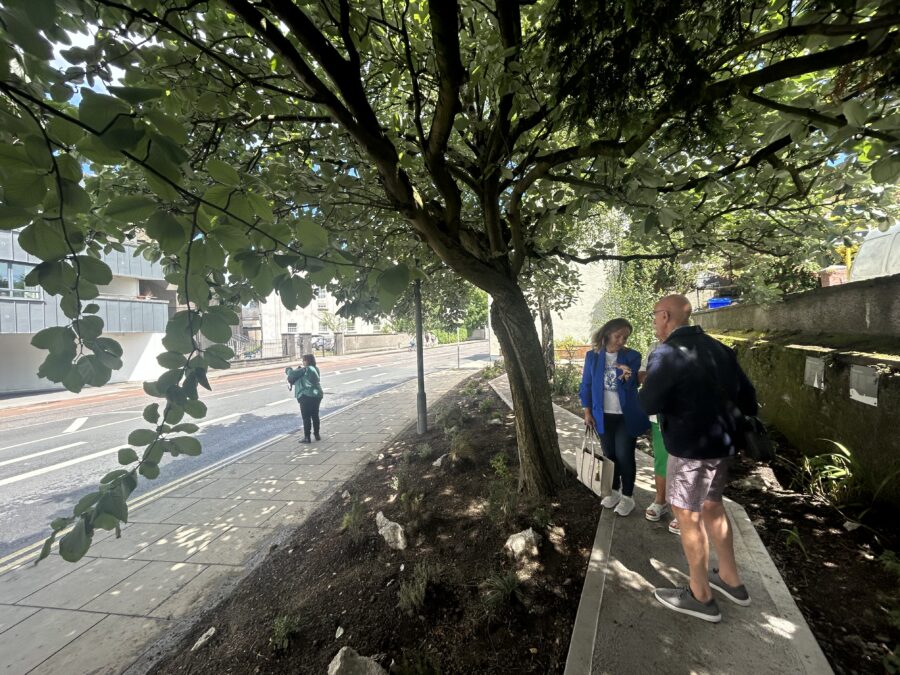
Kieran’s Our City, Our Town Article,
Cork Independent, 29 August 2024
Ronnie Herlihy Pocket Park at Langford Row
In recent weeks, Douglas Street Business Association in conjunction with Cork City Council launched a new pocket park at Langford Row. The park is in memory of the late Ronnie Herlihy, Local Historian, who wrote and gave walking tours across the South Parish. The new pocket park contains some of his writings on information panels.
The park is about unlocking more of the sense of place of the South Parish and sending people into a parish as Ronnie describes in his books “where you’ll find something of historical interest around almost every corner”.
In publishing his first edition of his South Parish book in 2003, Ronnie writes that he was aiming to do two things. Firstly, the book was simply meant to be a place one could go if they were interested in the rich heritage of the South Parish. Ronnie describes his work as, “a sort of one-stop-shop if you like, compiling between the covers of one book a list and some basic information about many of the historic places within the present parish, rather than having to search out the numerous different publications that contain articles or reports on those places”.
Secondly, Ronnie was hoping to awaken in people, no matter where they live, an awareness of their own surroundings, and “to get them thinking of the fantastic history all around them that has led to the making of this great City of Cork”.
Ronnie describes that all 1,000 copies of the initial South Parish book were sold. In the process €7,300 was donated to the Children’s Leukaemia Unit in the Mercy Hospital, being all the proceeds received from the sale of the book.
Ronnie undertook a second edition because of the number of times people asked him if the book was still available to buy. So, he published a second, revised edition. In doing a revised edition, it afforded Ronnie the opportunity to expand on many of the items in the original book. In Ronnie’s new introduction he quotes; “Having spent over 44 years either living or working in the heart of the South Parish, the area is in my blood. I’m still fascinated by the history of this part of Cork City, and as a proud member of the Cork South Parish Historical Society. We know that learning about the history of our own place is a never-ending process. Take a walk with me now in my own place, the open air museum that is the South Parish”.

The ‘awaken in people’ and the connection methodologies served Ronnie well in his next publication journey where he took on Victorian Cork. As he researched the South Parish, he spotted other nuggets of stories from Cork’s Victorian past, which took him off on another adventure.
Known as Victorian Cork, the book looked at events that occurred during the early Victorian period, from 1837 to 1859. The publication sought to as Ronnie noted “throw a little light onto the past, allowing the modern reader the opportunity of peering through the eyes of their Cork ancestors. It will hopefully give them a glimpse of a city that would only have been familiar to their grandparents, great-grandparents or great great-grandparents”.
The majority of the newspaper reports in his book were gleamed from the Cork Examiner, apart from the first few years between 1837 and 1841, when The Constitution or Cork Advertiser, was exclusively used. Where in our time it is easier than ever to use the digitised Irish Newspaper Archive from home, back in the day, Ronnie spent hour after hour, work lunchbreak after work lunchbreak turning physical newspaper pages and micro-film pages in Local Studies in Cork City Library.
Ronnie’s interest in people and their stories also brought him on his journey with his third book – this time returning to a physical space that of St Joseph’s Cemetery. The idea for writing this book followed on from research he carried out when he undertook a project on St Joseph’s Cemetery for the Annual Exhibition of the South Parish Historical Society.
That initial research, which looked at around two dozen burials in the cemetery, led to him as he quotes in his introduction spending many hours there in the summer of 2008, walking among the headstones of our ancestors, and “realising for the first time what an important historic gem we have here in the city”.
From that initial visit to research the project, as Ronnie explains in his introduction he was hooked. Ronnie followed that up by creating a powerpoint presentation that looked at the history of the cemetery, a number of those who are buried there, and some of the impressive monuments dotted around it. Afterwards, based on the presentation, Ronnie put together a walking tour of the cemetery. The next most logical step after that was to write a book.
In the immediate years leading up to his shock death, Ronnie’s interest in public history gathered further momentum. For many years Ronnie was a core part of the South Parish Historical Society annual exhibition – he was a core driver – and there was many a year he would spend hours and hours and hours involved in its organisation and its evolution
Ronnie’s adult education courses with Tom Spalding and others, regular phone ins with Neil Prendeville left many citizens wondering if they knew their city at all; it brought many citizens to Ronnie’s banner, so to speak, wishing to see the city through his eyes. In addition, there was his regularly gifting of photos and other snippets of Cork history to the world of Facebook.
The new pocket park is a fitting memory to Ronnie Herlihy – a great local historian but also a proud Corkonian.
Kieran’s September 2024 Tours, All free, 2 hours, no booking required:
- Sunday 1 September, The Friar’s Walk in association with Douglas Street Autumnfest; Discover Red Abbey and Barrack Street area, Meet at Red Abbey tower, off Douglas Street, 12noon.
- Sunday 8 September, Blackpool: Its History and Heritage; meet at square on St Mary’s Road, opp North Cathedral, 2pm.
- Saturday 14 September, Cork South Docklands; meet at Kennedy Park, Victoria Road, 2pm.
- Saturday 21 September, Fitzgerald’s Park: The People’s Park, meet at the park band stand, 2pm.
- Sunday 22 September, Stories from Blackrock and Mahon, meet in adjacent carpark at base of Blackrock Castle, 2pm.
Caption:
1268a. Ronnie Herilihy Pocket Park, Langford Row, Cork (picture: Kieran McCarthy).
1268b. The late Ronnie Herlihy.
Kieran’s Historical Walking Tours, September 2024
- Sunday 1 September, The Friar’s Walk; historical walking tour with Cllr Kieran McCarthy in association with Douglas Street Autumnfest; Discover Red Abbey, Elizabeth Fort, Barrack Street, Callanan’s Tower & Greenmount area; Meet at Red Abbey tower, off Douglas Street, 12noon (free, duration: two hours, no booking required).
- Sunday 8 September, Blackpool: Its History and Heritage; historical walking tour with Cllr Kieran McCarthy; meet at square on St Mary’s Road, opp North Cathedral, 2pm (free, duration: two hours, no booking required).
- Saturday 14 September, Cork South Docklands; Discover the history of the city’s docks, Historical walking tour with Cllr Kieran McCarthy, from quayside stories to the City Park Race Course and Albert Road; meet at Kennedy Park, Victoria Road, 2pm (free, two hours, no booking required).
- Saturday 21 September, Fitzgerald’s Park: The People’s Park, historical walking tour with Cllr Kieran McCarthy, from stories on the Mardyke to the Cork International Exhibition, meet at the band stand, 2pm (free, duration: 90 minutes, no booking required).
- Sunday 22 September, Stories from Blackrock and Mahon, Historical Walking Tour with Cllr Kieran McCarthy of Blackrock Village, from Blackrock Castle to Nineteenth Century Houses and Fishing; meet in adjacent carpark at base of Blackrock Castle, 2pm (free, 2 hours, finishes at railway line walk).
Kieran’s Our City, Our Town, 1 August 2024
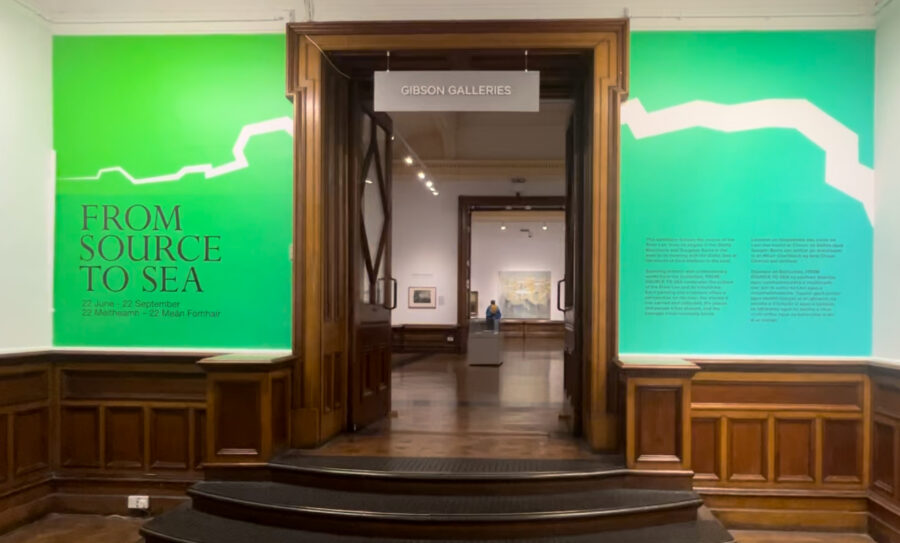
Kieran’s Our City, Our Town Article,
Cork Independent, 1 August 2024
From Source to Sea at the Crawford Art Gallery
One of the last exhibitions before the revamp of the Crawford Art Gallery celebrates the River Lee. The exhibition is entitled From Source to Sea and is on from 22 June to 22 September in the Gibson Galleries at Crawford Art Gallery.
The exhibition following the course of the River Lee, from its origins in the Shehy Mountains and Gougane Barra in the west to its meeting with the Celtic Sea at the mouth of Cork Harbour in the east, has opened at Crawford Art Gallery. Spanning historic and contemporary artworks from the collection, From Source to Sea celebrates the culture of Cork’s mighty Lee and its tributaries.
Artworks from the 1750s through to the present day are featured in the exhibition. Each painting, drawing, print, and sculpture offers a perspective on the river, the stories it has carried and collected, the places and people it has shaped, and the changes it has inevitably borne.
The exhibition features much-loved paintings, ranging from John Butts’ View of Cork from Audley Place (c.1750) and Whipping the Herring out of Town (c.1800) by Nathaniel Grogan, to George Mounsey Wheatley Atkinson’s Paddle Steamer Entering the Port of Cork (1842) and Skellig Night on South Mall (1845) by James Beale. These are joined by the work of artists Sarah Grace Carr, Kate Dobbin, John Fitzgerald, Robert Gibbings, Patrick Hennessy, Seán Keating, Diarmuid Ó Ceallacháin, and George Petrie.
Recent acquisitions by Ita Freeney, Bernadette Kiely, and Donald Teskey offer new contexts, while portraits by Séamus Murphy, Nano Reid, and Eileen Healy recall rich tales from the Lee Valley, including The Tailor and Ansty and the inimitable voice of Cónal Creedon.
In an overall sense, the exhibition encourages the viewer to reflect on the histories and perspectives of the River Lee Valley and to travel back from the city to the source in the Shehy Mountains. Michael Waldron, curator of the exhibition, says: ‘Following our popular exhibitions focusing on Cork city and harbour, it’s been such a pleasure to take a journey along the River Lee itself. I hope visitors will take as much enjoyment in following its course, connecting with the river’s rich history and culture, and maybe even get inspired to take their own stroll at Gougane Barra, Lee Fields, or the Marina”.
It has been over a decade since this column chronicled histories from the Lee Valley and recorded many oral histories from life within it. Some of these stories I have placed up on my website www.corkheritage.ie. At the time, I wrote that the origin of the name Lee is sketchy and legend reputedly attributes the name to an ethnic group known as the Milesians from Spain who reputedly arrived in Ireland several thousand years before the time of St. FinBarre. Legend has it that the Milesians acquired land in Southern Munster, which they named ‘Corca Luighe’ or ‘Cork of the Lee’ from Luighe, the son of Ith who attained the land after the Milesian advent to Ireland.
In addition, the River Lee – An Laoi over the centuries has had many variations in its spelling. In early Christian texts such as the Book of Lismore, it is described as Luae. It has also been written as Lua, Lai, Laoi and the Latin Luvius. An entry in the Annals of the Four Masters in the year 1163 A.D. names the River Sabhrann. However, many scholars agree on the name Lee as the most common name of the River.
The columns from over a decade ago also reflected upon the rich heritage of Gougane Barra. Most notably and grabbing the visitor’s eye at the start of the Crawford Art Gallery exhibition is a hand coloured and beautiful acquatint by Newton Fielding entitled “Gougane Barra Lake with the Hermitage of St Finbarr, County Cork”. It is a copy of George Petrie’s work.
George Petrie (1790-1866) was an important Irish landscape painter of his day. He explored people’s memories along with native Irish cultural traditions as he found them in the historic fabric of old monuments and buildings in the four corners of Ireland. He devoted himself to landscape painting in watercolours.
In 1819 Petrie supplied ninety-six illustrations for Cromwell’s Excursions Through Ireland. He subsequently furnished drawings for several publications, such as the Rev G N Wright’s Guide to Killarney, Guide to Wicklow and Historical Guide to Ancient and Modern Dublin, 1821, as well as Brewer’s Beauties of Ireland, 1825. Petrie’s appreciation of landscape was deeply indebted to William Wordsworth. He also had a constant awareness of the continuity between living folk art and antiquity. Petrie’s work explored the Irish landscape as a cultural echo informed by the lingering memories of native cultural traditions and antiquities.
Petrie’s work as a field officer with the Ordnance Survey of Ireland in the early nineteenth century was, according to art historian Peter Murray, an enormous salvage operation to collect and preserve the remains of Ireland’s native culture and identity. George Petrie’s Gougane Barra(one of two versions) attempts to put the viewer in the heart of the Shehy Mountains. Pilgrims/tourists seem dwarfed by awe-inspiring landscapes and give an increased interest and picturesque aspect to the scene.
Explore and rediscover the Lee Valley with From Source to Sea, whichis on from 22 June to 22 September in the Gibson Galleries at Crawford Art Gallery.
Captions:
1264a. Entrance to From Source to Sea, Crawford Art Gallery (picture: Kiran McCarthy).
1264b. Hand coloured and beautiful acquatint by Newton Fielding entitled “Gougane Barra Lake with the Hermitage of St Finbarr, County Cork”. It is a copy of George Petrie’s work.
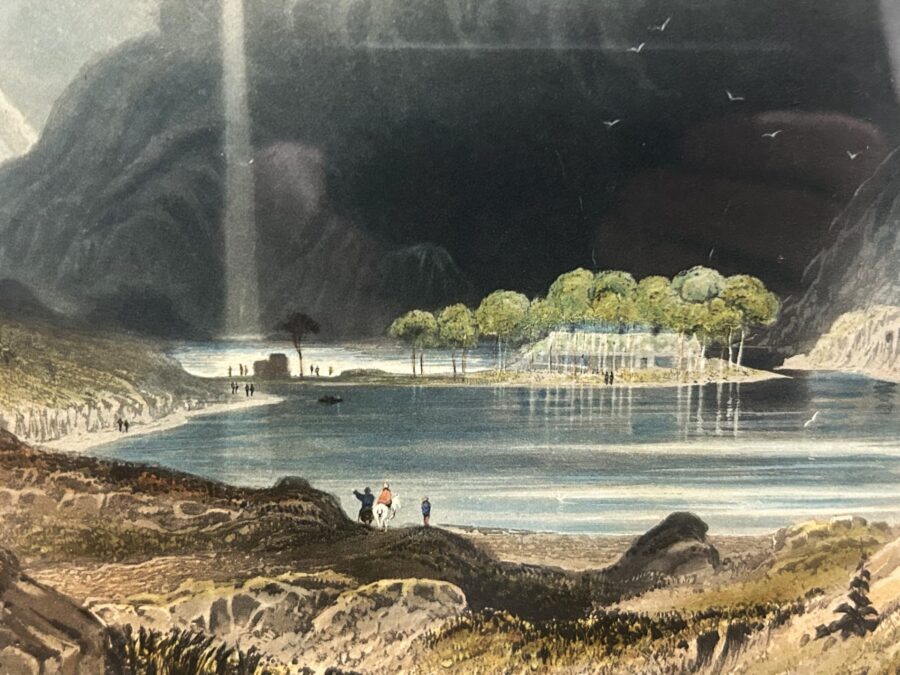
Cllr Kieran McCarthy’s July 2024 Historical Walking Tours:
All tours free, no booking required:
Friday 5 July, Cork Through the Ages, An Introduction to the Historical Development of Cork City; Historical walking tour; meet at the National Monument, Grand Parade, 6.30pm (free, two hours, no booking required).
Sunday 7 July 2024, The Northern Ridge – St Patrick’s Hill to MacCurtain Street; historical walking tour of the area around St Patrick’s Hill – Old Youghal Road to McCurtain Street; meet on the Green at Audley Place, top of St Patrick’s Hill, 6.30pm (free, two hours, no booking required).
Sunday 14 July 2024, Cork South Docklands; Discover the history of the city’s docks, historical walking tour, from quayside stories to the City Park Race Course and Albert Road; meet at Kennedy Park, Victoria Road, 6.30pm (free, two hours, no booking required).
Tuesday 16 July 2024, The Marina; historical walking tour; Discover the history of the city’s promenade, from forgotten artefacts to ruinous follies; meet at western end adjacent Shandon Boat Club, The Marina, 6.30pm (free, two hours, no booking required).
Wednesday 17 July 2024, Blackpool: Its History and Heritage, historical walking tour ; meet at square on St Mary’s Road, opp North Cathedral, 6.30pm, (free, two hours, no booking required).
Lord Mayor Cllr Kieran McCarthy’s Outgoing Speech, AGM, 21 June 2024
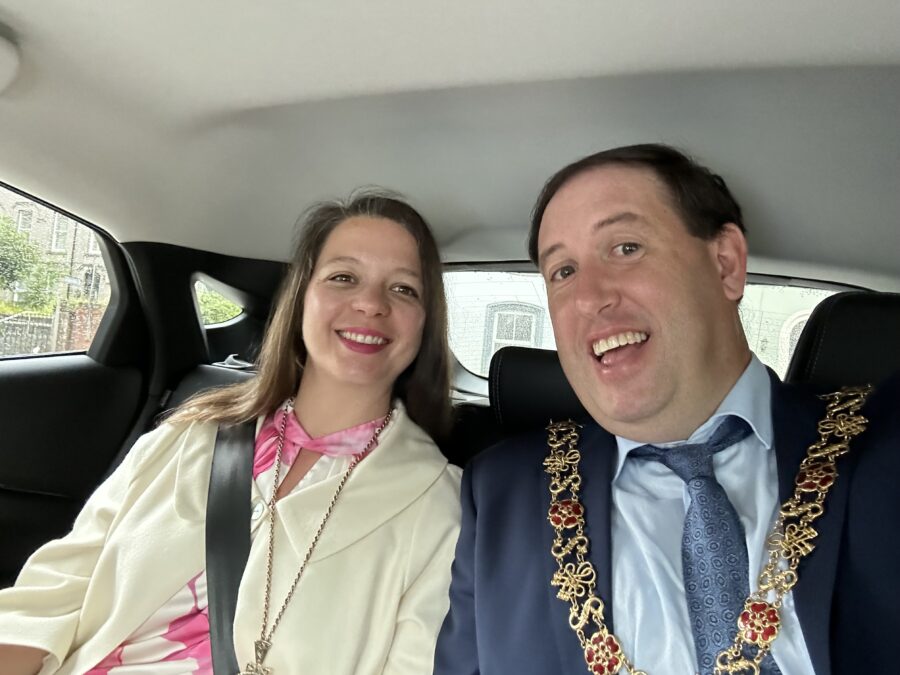
A Return to a Safe Harbour
Dear colleagues, Dear Chief Executive,
As outgoing Lord Mayor of Cork, a very warm welcome to the historic 1936 Council Chamber. A very warm welcome to those who have been re-elected and to those who this is your first time being an elected member of Cork City Council.
We also remember those who retired and those who didn’t make it back through the recent gruelling local elections.
And of course, one of the core parts of our AGM is to appoint our Council chair or the Lord Mayor.
And it will fall to me very shortly to take names of candidates interested in becoming Lord Mayor of Cork for the following year and to pass this eighteenth century chain of history to its next guardian so to speak.
I have but three very short reflections before we proceed.
Firstly, dear colleagues let us rejoice that the democratic process is very much alive in Cork.
My dear colleagues you have not only walked 1000s of kilometres in your quest or pilgrimage to take one of the 31 seats. You have gone to suburbia and into the inner city, and knocked on 1,000s of doors.
You have sacrificed your personal lives in a quest to be in the service of the people of Cork in local government.
It is also important to reflect on that pilgrimage that the process is not as easy as just walking and knocking on doors.
You must have belief in your message. It is a leap of faith. You have been tested. You had to be fit physically and more importantly emotionally.
You met people who befriended you straight away. You met people who closed the door in your face. You met people who had their own message.
You met people who are happy, who are sad, who are very angry, who shout in your face, who don’t want to talk, who are struggling in life, who seek a listener, who seek a chance, who are soaring in life, who buried a loved one, an hour before you called, a mother who just put their child to sleep, people who will ask you in for tea.
You encountered opinionated people and people who have no opinion,
people who are the salt of the earth, people who are guardian angels,
people who you perhaps wept for in your private moments,
people who you laughed with, people who invited you into their house to chat about this and that.
You have met survivors. You have met people who have given up on life. You met people who are lighthouses. Plus many more.
You are a pilgrim of sorts.
All of the conversations, debates and empathy with 1,000s of constituents or citizens and that personal connection piece makes Irish democracy one that is very important.
You have not only rang doorbells and physically pressed the flesh so to speak but deep dived down into citizen life listening to their concerns and now being able through your election as an elected member to bring these concerns into the historic Council Chamber here and to the wider City Hall.
We should never take democracy for granted especially in the world we live in today and that in some parts of the world there is no democracy.
A sincere thanks to all those who voted two weeks ago.
We as local politicians saw another part of the democratic process close up when it comes to counting the votes on ballot papers. The solid count process we have in Ireland and what we have witnessed in Cork is one to be heralded, be proud of and one where great credit is due to the Office of Corporate Affairs and the Office of Franchise in Cork.
And so my first message this evening is a nod on the importance of the canvass pilgrimage of sorts, the democratic process and one of thanks to you, our Council staff and especially to the citizens of our historic city who came out to support our recent local election and its democratic processes.
My second message to you concerns my year as Lord Mayor. Fifty-two weeks ago, the elected Council of the last Council term entrusted me with leadership of the Council.
That has been a really deep honour and it is one thing writing about Cork history, it is another being a part of it. Indeed, it is very difficult to sum up my experiences in a few sentences.
Looking at the diary since the last Cork City Council AGM in late June last year I have been engaged with over 1,600 events. On average there have been about 30-40 events a week depending on the season.
The days have been long and the diary has been very demanding but to get to explore Cork and many of its stories has been very fulfilling. One day can feel like three days when there are so many diary events to juggle!
One hour one could be at a presentation of cheques, or the presentation of certs, and the next you journey on and could be praising someone for their sporting achievement or helping open a new business, meeting an ambassador or giving a talk at one of Cork’s 118 schools or giving a tour of the Lord Mayor’s Office to various community groups.
All of these events look forward and build a sense of identity for Cork’s future. Some events have been varied ranging from a one person engagement to thousands of people. And of course, many of you popped up in the story boards as well to offer support.
However, across all of the events the common denominator has always been Cork. There are thousands of people in Cork engaged in not only its life and its story but enhancing its life and story. Every hour of everyday someone is doing something great for Cork and its communities.
Much of it goes without being seen but the office of Lord Mayor’s gets to what I call “deep dive” down into many stories and moments. In our city such stories matter or indeed such moments need to be cherished.
The sense of togetherness, stories and moments in Cork I have promoted and spoken at length about all year.
In particular I have harnessed the city’s coat of arms as a message – the two towers and the ship in between and the Latin inscription – Statio Bene Fida Carinis – or translated “a safe harbour for ships”. Whereas the element of shipping has almost moved from the city’s quays, the inscription could also be re-interpreted as a connection to people – that the city is also a safe harbour for people and community life. This is its greatest story and one the City needs to mind, keep vibrant, and for all of us in this historic and innovative city to keep working on.
But during this second message of the importance of stories and togetherness it also falls to me tosincerely thank the Deputy Lord Mayor Cllr Colette Finn for her expertise, support, positiveness and I would like to wish her well for the future,
the Lady Mayoress Marcelline for her patience, support and love, and for her charity work, singing and dancing and all round community building with different groups,
and to my parents, and siblings and wider family members for their support and love.
A sincere thanks to Finbarr Archer, Nicola O’Sullivan, Rose Fahy and Caroline Martin in the Lord Mayor’s office as well as the team in Corporate Affairs ably led by Paul Moynihan with support by Alma Murnane and Nuala Stewart – without such a team the office would not run effectively as it does but it is filled with people – a team – that really cares about the role of the office in our city and all the nuances attached to such a role
and also a sincere thanks to you Chief Executive Anne [Doherty], for your friendship, partnership, curation of activities, story board creation, support and advice over the past year. And I am very conscious that this is your last AGM, so many thanks for all your work.
My dear friends, let me conclude with my third message and if I am going to go down as the singing Lord Mayor let me end my Mayoralty where I started with a verse by Rogers and Hammerstein, which in its own way became a different kind of anthem during the year,
Oh, what a beautiful morning,
oh, what a beautiful day,
I got a beautiful feeling everything’s going Cork’s way,
eh, Oh what a beautiful Day.
Go raibh míle maith agaibh.
Ends.